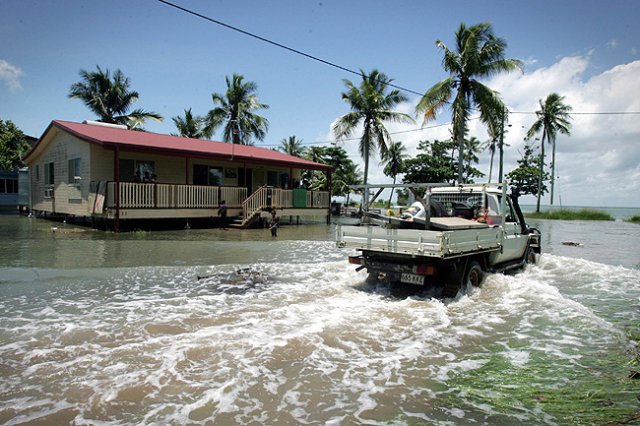
Joseph Elu, chair of the Torres Strait Regional Authority, told Radio National’s PM on January 5 that the islands that have been home to Indigenous people for thousands of years are “being inundated”, right now because of climate change.
“A couple of our islands, the tide rises over the sea walls of the beachfront and it flows under the houses and out the other end ... They’re predicting that in 100 years, then they’ll go under.”
In a frighteningly calm and resigned voice, he explained that while relocating entire communities before the islands go under may be needed, that is a “last option”. At the moment, the focus is on increasing the height of sea walls, protecting scarce freshwater supplies and even using sand to raise the islands 0.6 of a metre further above sea level.
The Intergovernmental Panel on Climate Change (IPCC) has long predicted that Indigenous people in Australia, along with other poor and marginalised groups, will disproportionately feel the impacts of climate change. Overcrowding and inadequate shelter, all too common in Top End Aboriginal communities, can increase exposure to water-borne disease during flooding, for example.
In the low-lying islands of the Torres Strait, the Regional Authority’s 2014-18Climate Change Strategypredictions make for sober reading. The report says that Torres Strait Island communities are among the most vulnerable to climate change in Australia. Predicted impacts range from loss of food species, loss of culture and increased physical and mental health issues, all the way through to complete uninhabitability of some islands.
For Torres Strait Islanders, as for all Aboriginal peoples, the health of their country is intrinsically connected to the health of their people and culture. Aboriginal people stand to lose more, and more quickly, from climate change.
However, globally, Aboriginal people are also often at the forefront of struggles to protect country from key drivers of climate change, such as the fossil fuel industry.
Amelia Telford, Indigenous coordinator for the Australian Youth Climate Coalition, wrote in October: “We know that our First Peoples are standing up against the fossil fuel industry and need to be front and centre when it comes to solving climate change.”
Aboriginal and Torres Strait Islander peoples lived sustainably on their country for tens of thousands of years. In many parts of particularly northern and remote Australia, they are still caring for some of the most significant and ecologically healthy ecosystems. They do this in the face of the destructive, capitalist system that arrived in 1788 — the same system that has led to them being marginalised and dispossessed in their own lands.
Increasingly, the ecological movements around the globe are embracing the concept of “climate justice”, which recognises that all peoples are not equally responsible for climate change. Some of the world’s poorest communities, including many indigenous peoples, will be the first to bear the brunt of ecological disasters, even though they have done little to contribute to the problem.
In Australia, the struggle to avoid runaway climate change must be linked to campaigns for Aboriginal land rights — and resources, funding and programs for Aboriginal people to effectively manage and care for country. Government subsidies to unsustainable industries — such as $4 billion to the fossil fuel industry — could be redirected to such programs.
Even the IPCC has noted the important role Aboriginal people could play in developing responses to climate change, given that they are “major land managers” in many parts of Australia.
But the Australian government refuses to take climate change seriously, let alone partner with Aboriginal people in Australia to develop adequate responses to it.
Meanwhile, on the Torres Strait Islands, perhaps Australia’s frontline in terms of the impacts of climate change, Joseph Elu is considering a new design of house “that can be moved or lifted up if necessary”.
This may help in the short term, but Elu warns: “We’ve got to have the long-term planning for what we do for the next 100 years”. He could be talking for the whole of humanity.
Like the article? Subscribe to Green Left now! You can also like us on Facebook and follow us on Twitter.